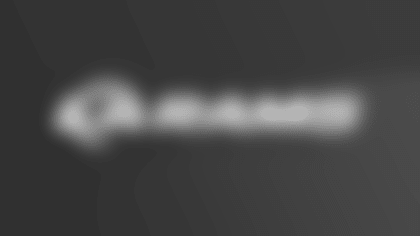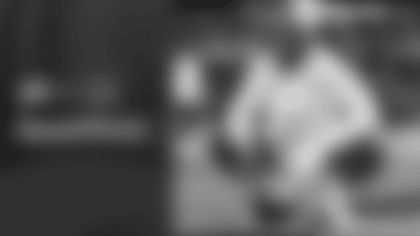The double-sided video board inside SoFi Stadium – future home of Super Bowl LVI – offers a groundbreaking video experience. Look no further than getting a chance to watch the NFL RedZone channel across both massive screens.
So does the stadium's roof, too.
On Tuesday, the Los Angeles Super Bowl Host Committee unveiled their logo on SoFi Stadium's semi-translucent roof.
And when the Rams were taking on the eventual Super Bowl champion Buccaneers in Tampa Bay on Monday Night Football in November, back in Inglewood, the game was being broadcast on SoFi Stadium's semi-translucent roof, making it the first venue to air live football on its roof.
"What we've done is very unique," Yanick Fournier, SACO Senior Vice President of Business Development, told theRams.com during a video conference in early December.
SACO has been around for 33 years, and while they've accomplished feats like inventing the first LED screen and the world's first LED touring screen (U2 Pop Mart Tour, 1997), successfully completing and implementing this project to make those kinds of aerial visuals possible was no small feat.
Though the production and installation took less than 12 months to complete, plans began forming five years ago, with SACO working with Lam Partners in Boston (lighting design) and stadium architects HKS to determine the feasibility of airing the game on the roof. According to Fournier, the lighting designers saw SACO's past work and wanted to see how they could pull it off.
"We work with these designers to come up with ways to see and learn on what is the best way to integrate," Fournier said. "When we looked at this five years ago, we looked at all the possibilities – the areas, the budget, what we wanted to achieve, coverage, the viewing angle. Do we want to go nighttime-only, daytime-only? Do we want to have double-sided, seeing it from inside the stadium and outside? All of that was put on the table and we came down to a conservative surface based on budget, and all the other constraints that come into play, and we have now a beautiful screen that has close to 27,000 V-PIX."
V-PIX is SACO's video pixel chain system comprised of puck-shaped chains with eight LEDs in each chain. According to the company's website, these chains are "designed to be suspended independently or integrated inside custom extruded housings with built-in power supplies," according to the company's website.
The nearly 27,000 V-PIX installed for this project were designed with gray bodies to match the roof's gray finish and connected by more than 62 miles of lead and jumper cables passed on and along the roof. Each "puck" was spaced five feet apart – the distance SACO's design team determined would achieve the desired video render following experimentation in the early days of the project.
To attach the pucks to the roof, SACO's design team collaborated with Pfeifer FabriTec – the manufacturers of SoFi Stadium's Ethylene Tetrafluoroethylene (ETFE) roof – to design a special clip made of ETFE to attach the cables and the brackets. RMJV, the electrical team working under stadium general contractor Turner-Aecom Hunt, and Pfeiffer worked together to install the setup, with a SACO supervision team on-site testing section by section to ensure everything was properly connected.
"It's a very big surface, there's a lot of bits and pieces that needed to come together in order to achieve what we were after," Fournier said.
Meanwhile, the 690 V-BRAINs – that supply power and data to the V-PIX – are "daisy-chained" together, mounted on the catwalk cluster-by-cluster and on the movable panels. A key part of the system's design was ensuring it could travel with the movable panel without cables getting cut.
"Some of them did get cut, and then they were adjusted and everything," Fournier said. "But those are the kind of challenges that we have to go through the design process and actually on-site condition process."
It's worth noting SACO had to commission the project remotely from Montreal via video calls with only some of the crew in Inglewood due to the ongoing COVID-19 pandemic.
"Okay, turn the light on, try this, put the drone up in the air but don't go too high," Fournier said, recalling the directions the SACO team gave from a distance. "So it was almost like commissioning this blind."
Besides the special clip and avoiding severed cables, SACO also had to install a second layer of pixels to ensure full coverage, or a full canvas, when the operable panels were open, by creating a different mapping of the pixels to allow the content to display properly.
"If they go into in Game Day, and they have an operable panel open, they press a button on the dashboard that we've created specifically for the Stadium, and then the pixel mapping will be the right one, and content will display properly," Fournier said.
The content comes from SACO's Video Processor and the content player, via an HDMI feed that displays any type of content. Fournier said SoFi Stadium and Hollywood Park Chief Technology Officer Skarpi Hedinsson's team connected SACO's content player to the stadium's master content player to display the game on the roof.
Collectively, Fournier explained, the system is a giant video screen which has a similar technology used by the Samsung LED screens for SoFi Stadium's video board, just at a different pixel pitch. Because anything can be displayed on it, the question then becomes, "what can we do with this?" according to Fournier.
The possibilities are seemingly endless.
"So we could work in collaboration with your team to create a specific ambience and look, because now you have a canvas that can be used 365 days in the year, from the minute the sun goes down to the end of the evening, you have a plenty going over every time," said Fournier, who also mentioned Hedinsson and his team are already working on different types of content. "We need to make it beautiful so that it changes every day."
Be there in 2021 as the Rams seek to become the second team to win the Super Bowl in their home stadium. Looking for the best seats and savings, plus exclusive access and offers throughout the year? Learn more about season tickets here.














